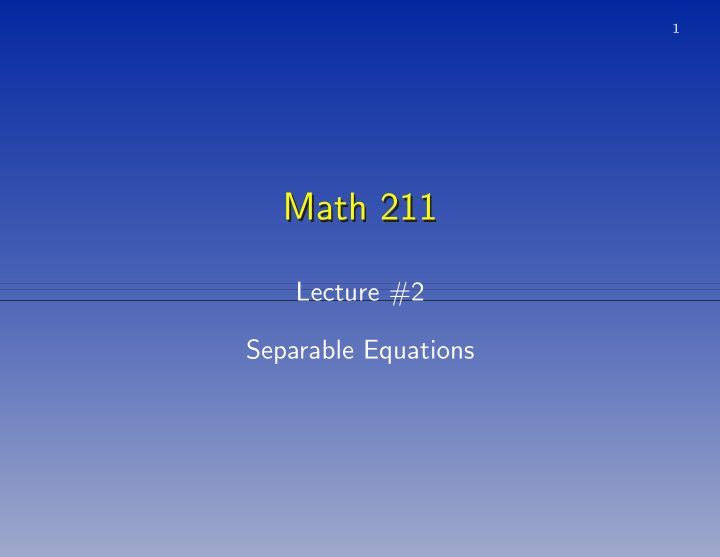



1 Math 211 Math 211 Lecture #2 Separable Equations
2 Interval of Existence Interval of Existence The largest interval over which a solution can exist. • Example: y ′ = 1 + y 2 y (0) = 1 with ⋄ General solution: y ( t ) = tan( t + C ) ⋄ Initial Condition: y (0) = 1 ⇔ C = π/ 4 . • Solution: y ( t ) = tan( t + π/ 4) exists and is continuous for − π/ 2 < t + π/ 4 < π/ 2 or for − 3 π/ 4 < t < π/ 4 .
3 Geometric Interpretation of Geometric Interpretation of y ′ = f ( t, y ) y ′ = f ( t, y ) If y ( t ) is a solution, and y ( t 0 ) = y 0 , then y ′ ( t 0 ) = f ( t 0 , y ( t 0 )) = f ( t 0 , y 0 ) . • The slope to the graph of y ( t ) at the point ( t 0 , y 0 ) is given by f ( t 0 , y 0 ) . • Imagine a small line segment attached to each point of the ( t, y ) plane with the slope f ( t, y ) .
4 The Direction Field The Direction Field x ’ = x 2 − t 4 3 2 1 0 x −1 −2 −3 −4 −2 0 2 4 6 8 10 t
5 Autonomous Equations Autonomous Equations General equation: dy dy dt = t − y 2 dt = f ( t, y ) Autonomous equation: dy dy dt = f ( y ) dt = y (1 − y ) In an autonomous equation the right hand side has no explicit dependence on the independent variable. Return
6 Equilibrium Points Equilibrium Points Autonomous equation: dy dy dt = f ( y ) dt = y (1 − y ) • Equilibrium point: f ( y 0 ) = 0 y 0 = 0 1 or • Equilibrium solution: y ( t ) = y 0 y ( t ) = 0 and y ( t ) = 1 Return
7 Between Equilibrium Points Between Equilibrium Points • dy dt = f ( y ) > 0 ⇒ y ( t ) is increasing. • dy dt = f ( y ) < 0 ⇒ y ( t ) is decreasing. Example: dy dt = y (1 − y ) Equilibrium point
8 Separable Equations Separable Equations General equation: dy dy dt = t − y 2 dt = f ( t, y ) Separable equation: dy dy dt = g ( y ) h ( t ) dt = t sec y In a separable equation the right hand side is a product of a function of the independent variable ( t ) and a function of the unknown function ( y ) . • Autonomous equations are separable. Return
9 Solving Separable Equations Solving Separable Equations dy dt = t sec y • Separate the variables: dy sec y = t dt cos y dy = t dt or We have to worry about dividing by 0, but sec y is never equal to 0. Return
10 Integrate both sides Integrate both sides � � cos y dy = t dt sin( y ) + C 1 = 1 2 t 2 + C 2 or sin( y ) = 1 2 t 2 + C where C = C 1 − C 2 . Step 1 Return
11 Solve for y Solve for y sin( y ) = 1 2 t 2 + C C + 1 � 2 t 2 � y ( t ) = arcsin . This is the general solution to dy dt = t sec y . Step 2 Return
12 Solving Separable Equations Solving Separable Equations The three step solution process: dy dt = g ( y ) h ( t ) dy g ( y ) = h ( t ) dt • Separate the variables. � � dy g ( y ) = h ( t ) dt • Integrate both sides. • Solve for y . Return
13 Examples Examples • y ′ = ry • R ′ = sin t R (0) = 1 , − 2 , − 1 with 1 + R 3 t 2 x • x ′ = x (0) = 1 , 0 with 1 + 2 x 2 • y ′ = 1 + y 2 y (0) = − 1 , 0 , 1 with Solution procedure Return
14 Why It Works Why It Works dy dt = g ( y ) h ( t ) 1 dy dt = h ( t ) if g ( y ) � = 0 g ( y ) � � 1 dy dt dt = h ( t ) dt g ( y ) � � 1 g ( y ) dy = h ( t ) dt Solution procedure Examples
Recommend
More recommend